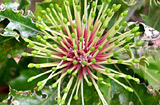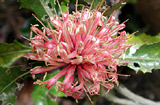|
[Front Page] [Features] [Departments] [Society Home] [Subscribe]

Coastal Sandplain and Heathland Plants of Western Australia
Banksia ilicifolia
Nicholas Mansergh
The splendour of a Banksia in flower incites uncontrollable passion. Those with a love of our amazing Banksia range will know exactly what I am talking about. Starship Enterprise with the Queen Mother at the helm could be flying right past you, but no, you only have eyes for that Banksia flower! On a recent project, where I was supposed to be working, I encountered such a problem. Along the Southern coast of Western Australia two Banksia species were doing their business and two species had already done their business. Do you think that I could confine myself to the task of path-building? Not on your life!
 |
Banksia ilicifolia may grow to about 10 metres in height. It is widespread in the south-west of Western Australia.
Select the thumbnail image or highlighted name for a higher resolution image (56k). Photo: Robert Nederpelt
|
Before a detailed and enraptured explanation of one of these beauties, I wish to state that where they grow in Western Australia reminds me of coastal Victoria in both climate and soil type. I wouldn't wonder that they would grow quite well in any of the southern coastal areas based on a sand profile and a cool Mediterranean climate with low humidity in the summer. The only challenges I can see are the notorious vulnerability to Phytophthora species (dieback) and to high humidity. Mind you, having said that, we have experienced an unusually "high humidity" summer this year and none of the banksias have left in search of drier pastures! Needless to say, wet feet, and non-free-draining soil are archenemies of our Banksia Beauties (excepting those swamp species), so these must be avoided by the usual methods of raised mounds (not less than one metre.... in fact the higher the better in some cases) of free-draining sand (or sandy soil). Not that many of us have the space to create our own sand-dune in the backyard, but a little negotiation and creative compromising might work. I can't see one's partner getting terribly excited about the prospect of the "Hill's Hoist" disappearing under an encroaching dune system, but it's definitely worth asking!
Interestingly, and very supportive of the horticultural practise of "mounding", these particular Banksia species were growing on natural raised mounds, above the surrounding low lying areas…..like islands in the heathlands. Not one did I find on the lowlands! Any evidence that was found, was either dead or dying and was less than 1 metre in height. As Phytophthora sp. has not "made it" into the National Park at this stage, I was left with the conclusion that these species (amongst others, of course) cannot "get past" the youthful seedling stage due to the slower drainage in the low areas. They never develop onto their full grown glory.
Nature, it seems, has Her own ways of keeping biodiversity within regions, and who are we to try and challenge that! However, a little stretching of Her limits, a little creative imagination and we're away!
Whilst everywhere in Southern Australia may get some summer rain (although here in Perth that can be debatable!), I think the big trick is to stop oneself going for the hose. Yes, it has been proven that some of Australian native plants will perform better with good growth, etc with extra watering over summer, but I hardly would dare apply that to the Western Australian banksias that grow so very well without extra watering. In fact, extra watering over summer can be their downfall. They have developed very specialised mechanisms to survive in our hot and dry climate, so "going against the grain" of nature is only asking for trouble in other States, let alone here in Western Australia.
Firstly, and well documented, is the growing of a long tap root and several lateral roots that in turn develop their own tap roots. The long central tap root penetrates the ground water table. At the end of the Western Australian summer (the driest time of the year!) the water table may be anything up to 2 - 3 metres underground (if not more in some places) and the top 2 - 3 metres is mostly dry sand (with progressively more moisture as you descend the soil profile). Yet the banksias put on their best and make the majority of new growth at this time.
Secondly, and also well documented, is the banksia's annual development of that most specialised of root systems, the proteoid roots. We are familiar with their purpose of extracting phosphorus from extremely low-phosphorus soils. These roots grow in profusion in the winter-wet months and extract all the nutrients they can, storing them in the plants' cells for utilization in the autumn flowering and regrowth. In the summer months, as the water table drops, the proteoid roots die back and the tap root and laterals take over the main survival function of water replenishment.
 |
Proteoid roots can often be seen by carefully removing a proteaceous plant from its pot, as shown here.
Select the thumbnail image or highlighted name for a higher resolution image (39k).
|
It is these very sensitive proteoid roots that are also its downfall when it comes to Phytophthora sp. This little fungus just loves moist, (or wet), warm and free-draining soils/sands. The worst (or best, depending on which way you look at it) times for the production of the fungal spores is when warm wet conditions prevail, ie. spring/autumn; at these times their spore production rates can be phenomenal. Being very sensitive, the proteoid root system is a particularly easy target for Phytophthora attack, let alone other pathogens that inhabit our soils. Essentially, Western Australian banksias have developed, in isolation, very specialized mechanisms of survival that do not require tampering with by we mere mortals. To do so may be courting death of the plant. Why risk danger by encouraging these roots to form in times when they do not normally form? Back to the point at hand .....I tend to follow Edna Walling's advice on pruning and apply it to watering "When in doubt, Don’t!". The only exception to this, is drought stressed plants in their first year and, even then, one water once a month just to keep it alive.
 |
The flowers of Banksia ilicifolia are usually reddish at the base and cream above (left top) but age to a deep pink or red (left bottom).
Select the thumbnail image or highlighted name for a higher resolution image (60 and 50k). Photos: Gwyn Clarke.
|
 |
Moving on to those glorious banksias in D'Entrecasteaux National Park... ..Banksia ilicifolia (holly-like leaves) was blooming away, with a beautiful pale green inflorescence, turning red with age, reminiscent of more of a dryandra flower than a banksia. This particular species (amongst others, including B.cuneata) is proof of that borderline relationship between Dryandra and Banksia. So much like a Dryandra in many respects, (however, the seed cone gives it away) that one marvels the taxonomical nightmare of many of our Australian plants. This Banksia is, in fact, quite a common (or was once) species with a wide distribution over much of the south-western region of the state. It is found in several plant communities or biodiversity regions, from the sandplains north of Perth (in stands with B.menziesii and B.attenuata) to the southern coastal regions (in sometimes pure stands or with B.grandis, etc).
 |  |
The fruits of B.ilicifolia (left) have only a few seed-bearing follicles. The flowers, also, are unlike most Banksia species and occur in clusters more like Dryandra, as illustrated by Dryandra tenuifolia.
Select the thumbnail image or highlighted name for a higher resolution image (41k and 24k). Photos: Tony Nederpelt (left) and Margaret Pieroni (right).
|
B.ilicifolia grows from a sea wind blasted dwarf tree/shrub to a small tree (around 5 - 7 metres) in the more sheltered areas behind the first main dune system from the beach and on mounds in the heathlands. It is always found growing in what looks like (for all intent and purpose) pure sand. I am sorry to report that if clay is your base, then this banksia isn't. It would do very well in a large tub, with provision for better drainage than is often supplied in most pots, an excellently draining sand/sandy soil, in a sunny spot, and Bob's your uncle! Remember to avoid any additional fertilizers, except perhaps low phosphorous OsmocoteTM. If growing this, or any other western Banksia in large tubs, then the watering regime must be strictly monitored. Naturally, in a pot, the plant cannot extend its tap root to the ground water table, so some watering is a must. In respect to this, keep in mind its natural growing conditions in the West. I highly recommend letting the sand/sandy soil become almost dry before watering again during the summer months. I think that if there is moisture in the bottom half of the tub, then B.ilicifolia will flourish, even if the top half of the pot appears almost bone dry. Further, when watering, I recommend not wetting the leaves or flowers above ground, if possible; it only adds to higher humidity which they positively loathe.
On a general cultivation level, Banksia ilicifolia grows easily from seed, although the time it can take for the seeds to germinate is very variable. Some might germinate within a week or so, others up to 90 days, so keep up the watering until there is no doubt that the seed has either failed to germinate or has become ant fodder! They are very prone to damping off and other fungal diseases in the early stages, so the usual free-draining propagating mix, and other recommended care, is essential. The seed, available through many seed suppliers, is very expensive due to low seed setting in the plant. Most often only one seed, sometimes two, will be produced on the cone and in some years no seed will be set at all.
If you can get it, do try it, it is beautiful.
Note: Other Banksia's within the Park were Banksia grandis, B.littoralis and B.quercifolia .........but more about these another time.
Nicholas Mansergh, by his own admission, is a middle-aged "nutter", whose main concerns in life are plants, conservation, and gardening.

[Front Page] [Features] [Departments] [Society Home] [Subscribe]
Australian Plants online - December 1999
Association of Societies for Growing Australian Plants
|